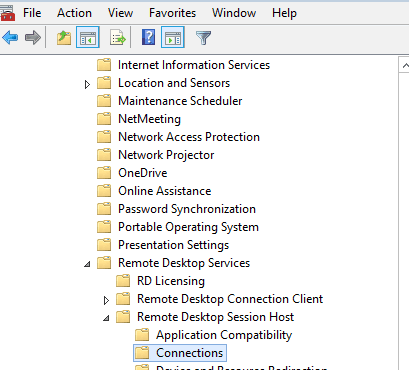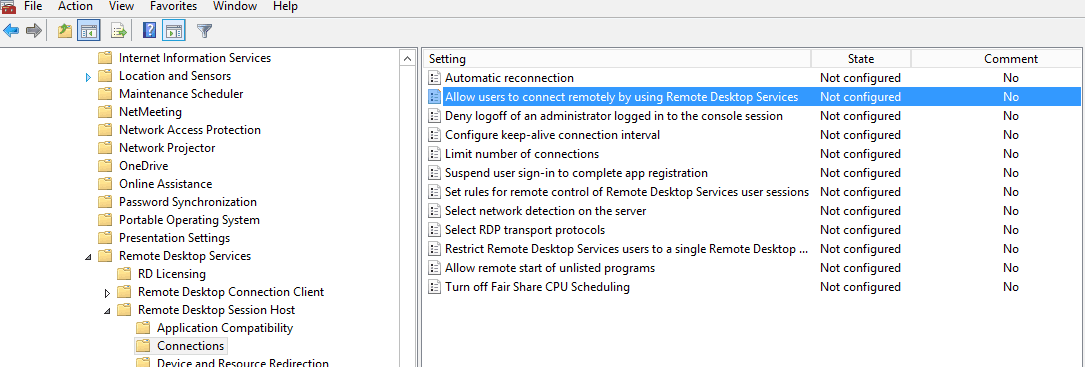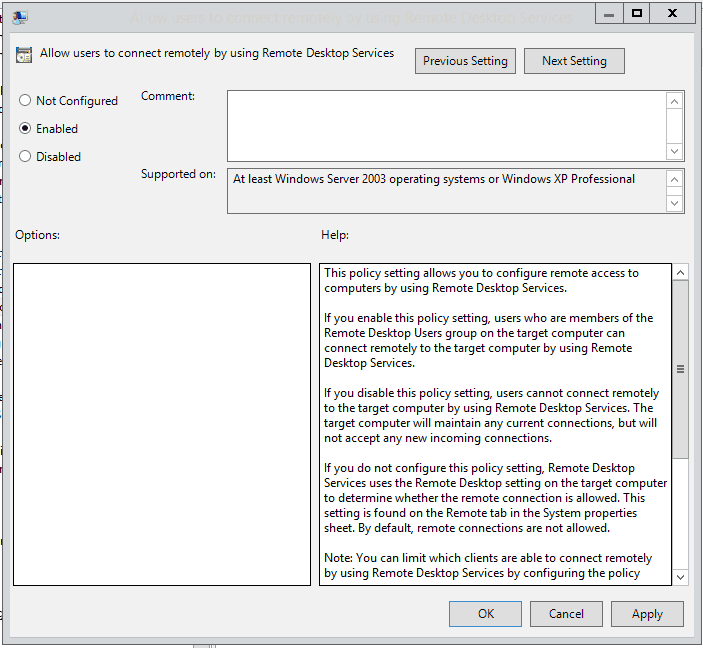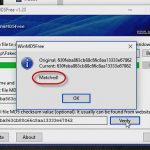How to Remotely Enable and Disable (RDP) Remote Desktop
How to Remotely Enable and Disable (RDP) Remote Desktop
By default on a Windows Server Product Windows Remote Management (WinRM) is enabled, but Remote Desktop (RDP) is Disabled. On workstation operating systems neither is enabled by default, so if you want to be able to accomplish the following you will need to enable WinRM on the workstations.
Enabling RDP remotely.
Method 1: Command Line
To enable RDP with the Command Prompt, use the following steps.
- Launch the Command Prompt as Administrator.
- Type the following command:
1 | Reg add “\\computername\HKLM\SYSTEM\CurentControlSet\Control\Terminal Server” /v fDenyTSConnections /t REG_DWORD /d 0 /f |
Note: Computername is the name of the computer you wish to enable RDP on.
NOTE: Enabling RDP through the Command Prompt will not configure the Windows Firewall with the appropriate ports to allow RDP connections.
NOTE: By default the local Administrators group will be allowed to connect with RDP. Also the user that is currently logged in will also be allowed to connect.
To disable RDP with the Command Prompt, use the following steps.
- Launch the Command Prompt as Administrator.
- Type the following command:
1 | Reg add “\\computername\HKLM \SYSTEM\CurentControlSet\Control\Terminal Server” /v fDenyTSConnections /t REG_DWORD /d 1 /f |
Method 2: Using PowerShell
To enable RDP with the PowerShell, use the following steps.
Option 1
To enable RDP:
- Launch PowerShell as Administrator.
- Type the following command and create a script block and use the Invoke-Command cmdlet:
1 | Invoke-Command –Computername “server1”, “Server2” –ScriptBlock {Set-ItemProperty -Path "HKLM:\System\CurrentControlSet\Control\Terminal Server" -Name "fDenyTSConnections" –Value 0} |
NOTE: Enabling RDP through PowerShell will not configure the Windows Firewall with the appropriate ports to allow RDP connections.
Type the following:
1 | Invoke-Command –Computername “server1”, “Server2” –ScriptBlock {Enable-NetFirewallRule -DisplayGroup "Remote Desktop"} |
NOTE: By default the local Administrators group will be allowed to connect with RDP. Also the user that is currently logged in will also be allowed to connect.
To disable RDP with the PowerShell, use the following steps.
- Launch PowerShell as Administrator.
- Type the following command:
1 | Invoke-Command –Computername “server1”, “Server2” –ScriptBlock {Set-ItemProperty -Path "HKLM:\System\CurrentControlSet\Control\Terminal Server" -Name "fDenyTSConnections" –Value 1} |
Option 2
To enable RDP RDP with the PowerShell, use the following steps.
- Launch PowerShell as Administrator.
- Create a PS Session with the desired target computer.
- Type the following command once possession is established:
1 | Set-ItemProperty -Path "HKLM:\System\CurrentControlSet\Control\Terminal Server" -Name "fDenyTSConnections" –Value 0 |
NOTE: Enabling RDP through PowerShell will not configure the Windows Firewall with the appropriate ports to allow RDP connections.
Type the following:
1 | Enable-NetFirewallRule -DisplayGroup "Remote Desktop" |
NOTE: By default the local Administrators group will be allowed to connect with RDP. Also the user that is currently logged in will also be allowed to connect.
To disable RDP RDP with the PowerShell, use the following steps.
- Launch PowerShell as Administrator.
- Create a PS Session with the desired target computer.
- Type the following command once possession is established:
1 | Set-ItemProperty -Path "HKLM:\System\CurrentControlSet\Control\Terminal Server" -Name "fDenyTSConnections" –Value 1 |
Method 3: Use Group Policy
If you have numerous Servers and/or Workstations that you need to enable RDP on and they are in the same Organization Unit structure in Active Directory you should enable RDP through Group Policy.
To enable RDP Using Group Policy.
- Launch the Group Policy Management Console (GPMC)
- Either edit an existing Group Policy Object (GPO) or create a new GPO.
- Navigate to the following GPO node:
Computer Configuration\Administrative Templates\Windows Components\Remote Desktop Services\Remote Desktop Session Host\Connections
- In the Settings pane double click Allow users to connect remotely by using Remote Desktop Services.
- Select the Enable Radial button select OK.
- Close the GPO editor and link the GPO to the appropriate Organizational Unit.
NOTE: Enabling RDP through GPO will configure the Windows Firewall with the appropriate ports to allow RDP connections.
Note: In all the methods demonstrated in this blog any member of the local Remote Desktop Users group will be able to connect to the target computers.
Until next time – Ride Safe!
Rick Trader
Windows Server Instructor – Interface Technical Training
Phoenix, AZ
You May Also Like
A Simple Introduction to Cisco CML2
0 3896 0Mark Jacob, Cisco Instructor, presents an introduction to Cisco Modeling Labs 2.0 or CML2.0, an upgrade to Cisco’s VIRL Personal Edition. Mark demonstrates Terminal Emulator access to console, as well as console access from within the CML2.0 product. Hello, I’m Mark Jacob, a Cisco Instructor and Network Instructor at Interface Technical Training. I’ve been using … Continue reading A Simple Introduction to Cisco CML2
Creating Dynamic DNS in Network Environments
0 642 1This content is from our CompTIA Network + Video Certification Training Course. Start training today! In this video, CompTIA Network + instructor Rick Trader teaches how to create Dynamic DNS zones in Network Environments. Video Transcription: Now that we’ve installed DNS, we’ve created our DNS zones, the next step is now, how do we produce those … Continue reading Creating Dynamic DNS in Network Environments
Cable Testers and How to Use them in Network Environments
0 727 1This content is from our CompTIA Network + Video Certification Training Course. Start training today! In this video, CompTIA Network + instructor Rick Trader demonstrates how to use cable testers in network environments. Let’s look at some tools that we can use to test our different cables in our environment. Cable Testers Properly Wired Connectivity … Continue reading Cable Testers and How to Use them in Network Environments








See what people are saying...